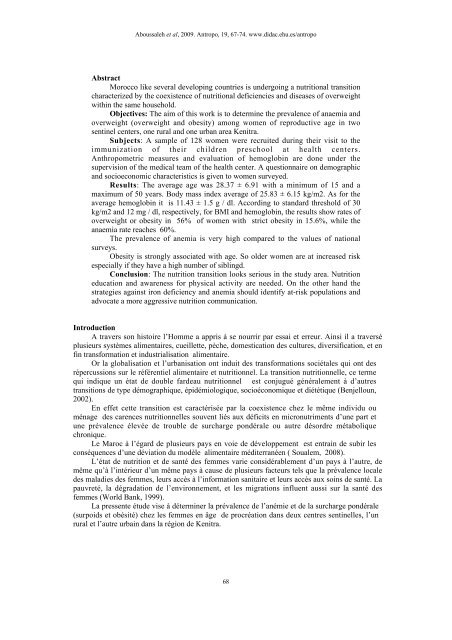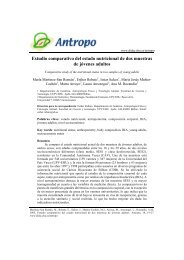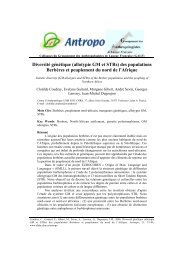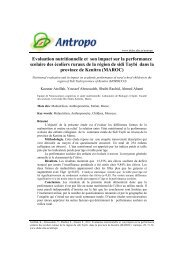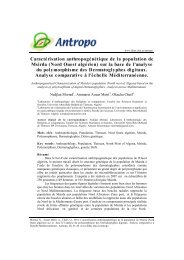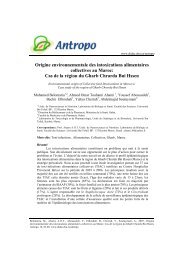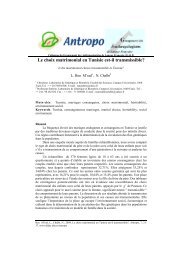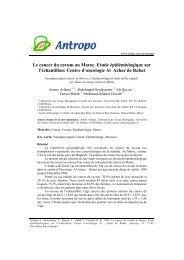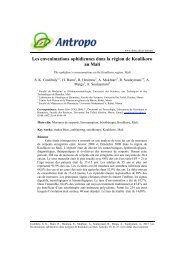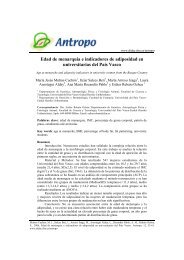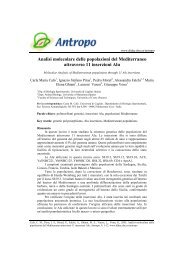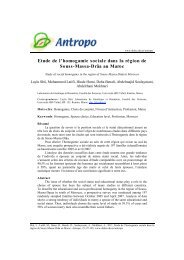Transition nutritionnelle au Maroc: Coexistence de l ... - Antropo
Transition nutritionnelle au Maroc: Coexistence de l ... - Antropo
Transition nutritionnelle au Maroc: Coexistence de l ... - Antropo
You also want an ePaper? Increase the reach of your titles
YUMPU automatically turns print PDFs into web optimized ePapers that Google loves.
Aboussaleh et al, 2009. <strong>Antropo</strong>, 19, 67-74. www.didac.ehu.es/antropo<br />
Abstract<br />
Morocco like several <strong>de</strong>veloping countries is un<strong>de</strong>rgoing a nutritional transition<br />
characterized by the coexistence of nutritional <strong>de</strong>ficiencies and diseases of overweight<br />
within the same household.<br />
Objectives: The aim of this work is to <strong>de</strong>termine the prevalence of anaemia and<br />
overweight (overweight and obesity) among women of reproductive age in two<br />
sentinel centers, one rural and one urban area Kenitra.<br />
Subjects: A sample of 128 women were recruited during their visit to the<br />
immunization of their children preschool at health centers.<br />
Anthropometric measures and evaluation of hemoglobin are done un<strong>de</strong>r the<br />
supervision of the medical team of the health center. A questionnaire on <strong>de</strong>mographic<br />
and socioeconomic characteristics is given to women surveyed.<br />
Results: The average age was 28.37 ± 6.91 with a minimum of 15 and a<br />
maximum of 50 years. Body mass in<strong>de</strong>x average of 25.83 ± 6.15 kg/m2. As for the<br />
average hemoglobin it is 11.43 ± 1.5 g / dl. According to standard threshold of 30<br />
kg/m2 and 12 mg / dl, respectively, for BMI and hemoglobin, the results show rates of<br />
overweight or obesity in 56% of women with strict obesity in 15.6%, while the<br />
anaemia rate reaches 60%.<br />
The prevalence of anemia is very high compared to the values of national<br />
surveys.<br />
Obesity is strongly associated with age. So ol<strong>de</strong>r women are at increased risk<br />
especially if they have a high number of siblingd.<br />
Conclusion: The nutrition transition looks serious in the study area. Nutrition<br />
education and awareness for physical activity are nee<strong>de</strong>d. On the other hand the<br />
strategies against iron <strong>de</strong>ficiency and anemia should i<strong>de</strong>ntify at-risk populations and<br />
advocate a more aggressive nutrition communication.<br />
Introduction<br />
A travers son histoire l’Homme a appris à se nourrir par essai et erreur. Ainsi il a traversé<br />
plusieurs systèmes alimentaires, cueillette, pèche, domestication <strong>de</strong>s cultures, diversification, et en<br />
fin transformation et industrialisation alimentaire.<br />
Or la globalisation et l’urbanisation ont induit <strong>de</strong>s transformations sociétales qui ont <strong>de</strong>s<br />
répercussions sur le référentiel alimentaire et nutritionnel. La transition <strong>nutritionnelle</strong>, ce terme<br />
qui indique un état <strong>de</strong> double far<strong>de</strong><strong>au</strong> nutritionnel est conjugué généralement à d’<strong>au</strong>tres<br />
transitions <strong>de</strong> type démographique, épidémiologique, socioéconomique et diététique (Benjelloun,<br />
2002).<br />
En effet cette transition est caractérisée par la coexistence chez le même individu ou<br />
ménage <strong>de</strong>s carences <strong>nutritionnelle</strong>s souvent liés <strong>au</strong>x déficits en micronutriments d’une part et<br />
une prévalence élevée <strong>de</strong> trouble <strong>de</strong> surcharge pondérale ou <strong>au</strong>tre désordre métabolique<br />
chronique.<br />
Le <strong>Maroc</strong> à l’égard <strong>de</strong> plusieurs pays en voie <strong>de</strong> développement est entrain <strong>de</strong> subir les<br />
conséquences d’une déviation du modèle alimentaire méditerranéen ( Soualem, 2008).<br />
L’état <strong>de</strong> nutrition et <strong>de</strong> santé <strong>de</strong>s femmes varie considérablement d’un pays à l’<strong>au</strong>tre, <strong>de</strong><br />
même qu’à l’intérieur d’un même pays à c<strong>au</strong>se <strong>de</strong> plusieurs facteurs tels que la prévalence locale<br />
<strong>de</strong>s maladies <strong>de</strong>s femmes, leurs accès à l’information sanitaire et leurs accès <strong>au</strong>x soins <strong>de</strong> santé. La<br />
p<strong>au</strong>vreté, la dégradation <strong>de</strong> l’environnement, et les migrations influent <strong>au</strong>ssi sur la santé <strong>de</strong>s<br />
femmes (World Bank, 1999).<br />
La pressente étu<strong>de</strong> vise à déterminer la prévalence <strong>de</strong> l’anémie et <strong>de</strong> la surcharge pondérale<br />
(surpoids et obésité) chez les femmes en âge <strong>de</strong> procréation dans <strong>de</strong>ux centres sentinelles, l’un<br />
rural et l’<strong>au</strong>tre urbain dans la région <strong>de</strong> Kenitra.<br />
68


